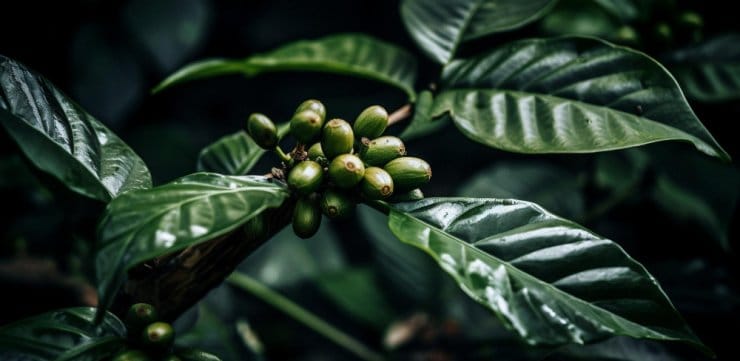The Rubiaceae family of plants is one of the world’s most diverse and widespread plant families. With over 13,500 species, this family includes many flowering plants, trees, and shrubs, ranging from coffee and gardenia to cinchona and erigeron. They are commonly found in tropical and subtropical regions worldwide and are highly diverse in their morphology, ecology, and uses. In this blog post, we’ll explore the characteristics of this fascinating family of plants and the many different ways they are used in our everyday lives.
Taxonomy Of Ribiaceae Family
Taxonomically, the family is classified within the kingdom Plantae, division Magnoliophyta, class Magnoliopsida, and subclass Asteridae. The family is divided into subfamilies, tribes, genera, and species based on morphological and genetic characteristics. The naming of plants within the Rubiaceae family follows the principles of binomial nomenclature. Each plant is given a unique scientific name consisting of a genus name followed by a specific epithet.
For example, the coffee plant, which belongs to Coffea, is scientifically named Coffea arabica. The genus name is always capitalized, while the specific epithet is written in lowercase. This naming system ensures consistency and clarity in identifying and classifying plants within the Rubiaceae family.
Taxonomy is crucial in understanding the relationships between different species within the Rubiaceae family. By classifying plants based on their shared characteristics, taxonomists can trace the evolutionary history of these plants and identify their closest relatives. This information is vital for conservation efforts and helps researchers in botany and pharmacology study and analyze the diverse plant species within the Rubiaceae family.
Characteristics Of The Rubiaceae Family
- The Rubiaceae family is known for its distinct characteristics that set it apart from other plant families.
- One key characteristic is the presence of opposite leaves, which grow in pairs on opposite sides of the stem. This is a notable feature of many plants in this family, such as coffee and gardenias.
- Another defining characteristic is the arrangement of flowers. Most flowers in this family have a unique pattern where the petals form a funnel or tube shape. The flowers are typically small and have five petals, often in vibrant colors like white, pink, or yellow. This flower arrangement is seen in plants like the Ixora and the periwinkle.
- The fruits of plants often take the form of capsules or berries. These fruits contain seeds and are an important means of reproduction and dispersal for plants.
- Another notable characteristic is the presence of milky latex or sap in many members of this family. This milky latex is often medicinal and traditionally used for various purposes, including treating wounds and ailments.
Importance Of The Rubiaceae Family In Medicine And Culture
The Rubiaceae family of plants holds great importance in both medicine and culture. Many species within this family have been utilized for their medicinal properties for centuries. One well-known example is the coffee plant (Coffea), a member of the Rubiaceae family. Coffee beans are rich in caffeine, which stimulates the central nervous system, and is commonly consumed as a morning pick-me-up.

Another notable plant within this family is the Cinchona tree (Cinchona officinalis), which is the source of quinine. Quinine has long been used as a treatment for malaria due to its antimalarial properties. It is still utilized today, particularly in regions where malaria is prevalent.
Mitragyna speciosa tree, commonly known as kratom , is another species gaining popularity in the US. Most potent Kratom strains on SupernaturalBotanical.com have been used for centuries in traditional medicine in Southeast Asia for their stimulant and relieving properties. They contain alkaloids, including mitragynine and 7-hydroxymitragynine, which interact with opioid receptors in the brain, providing relief and potentially reducing withdrawal symptoms.
In addition to their medicinal uses, many plants within the Rubiaceae family hold cultural significance. For example, the khat plant (Catha edulis) is a member of this family and is commonly chewed in certain African and Middle Eastern cultures for its stimulant effects. It is used during social gatherings and is considered a symbol of hospitality.
Common Examples Of Plants In The Rubiaceae Family
Numerous common examples of well-known and widely used plants exist within this family.
- One example is the coffee plant (Coffea), grown for its roasted beans and ground to make coffee.
- Another popular plant in the Rubiaceae family is the quinine tree (Cinchona), the source of quinine, a medication used to treat malaria.
- The gardenia plant (Gardenia jasminoides) is also a member of the Rubiaceae family. This plant is well-known for its fragrant white flowers and is often used in perfumes and as an ornamental plant in gardens.
- Other notable examples are the madder plant (Rubia tinctorum) and the cat’s claw plant (Uncaria tomentosa). Each of these plants has unique characteristics and uses, highlighting the diversity and importance of the Rubiaceae family in various aspects of human life.
Threats To The Rubiaceae Family And Conservation Efforts
Unfortunately, like many other plant families, the Rubiaceae family also faces various threats that jeopardize its existence.
- Habitat loss: One of the major threats is habitat loss due to deforestation and urbanization. As forests are cleared to make way for agriculture or infrastructure development, many species within the Rubiaceae family lose their natural habitat and struggle to survive.
- Overexploitation: Another threat is overexploitation for medicinal purposes. Many plants in the Rubiaceae family, such as the Cinchona tree (source of quinine), are widely used for their medicinal properties. However, unsustainable harvesting practices can deplete populations and put species at risk of extinction.
- Climate change: It also poses a significant threat to the Rubiaceae family. As temperatures rise and rainfall patterns become erratic, the delicate balance required for the survival of these plants can be disrupted. Species may struggle to adapt to these changing conditions, leading to population declines.
To mitigate these threats, conservation efforts are crucial. Efforts are being made to protect and restore the natural habitats of Rubiaceae plants through the establishment of protected areas and conservation projects. Several organizations are working to preserve and restore its habitat such as by reforestation or protecting key areas of land. The International Union for Conservation of Nature (IUCN) also provides a Red List of Threatened Species that includes many Rubiaceae species.
These designations can help guide conservation efforts and prioritize actions to save at-risk species. Additionally, sustainable harvesting practices are being promoted to ensure the long-term survival of medicinal species.Education and awareness programs are also important in promoting the value of the Rubiaceae family and the need for its conservation. By highlighting the important role these plants play in ecosystems and their cultural significance, it becomes easier to rally support and action for their protection.
Conclusion
The Rubiaceae family is a diverse group of plants that includes some of the world’s most well-known and widely used species. From the medicinal properties of coffee and quinine to the vibrant blooms of gardenias and hibiscus, this family offers many benefits to humans and the environment. However, the Rubiaceae family also faces habitat loss, climate change, and overexploitation threats.
We need to recognize the value of these plants and take steps to conserve and protect them. We can ensure that it continues to thrive and contribute to our world through research, conservation efforts, and sustainable practices. As we continue to study and appreciate the Rubiaceae family, we gain a deeper understanding of the intricate web of life on our planet and the importance of preserving biodiversity.


